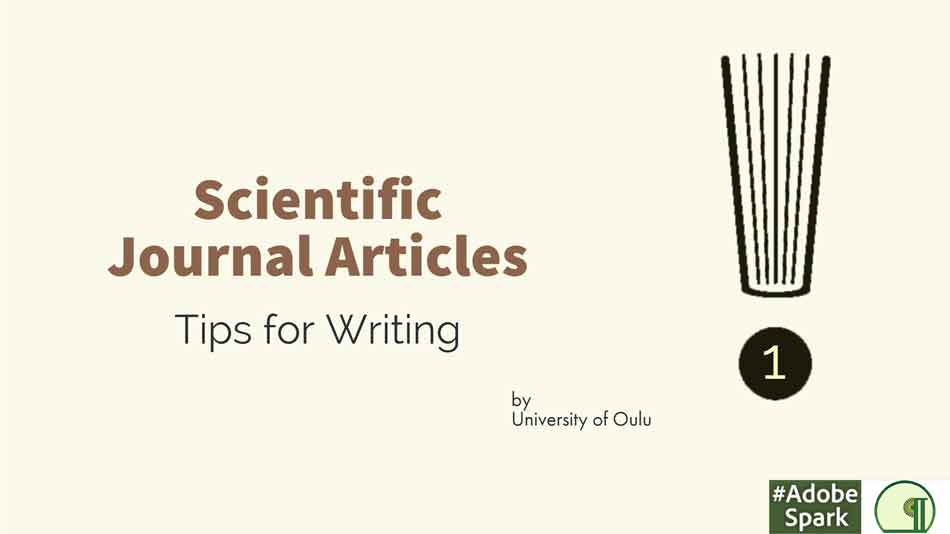Tips for Writing Scientific Journal Articles

Introduction
Being capable of publishing in peer-reviewed journals is commonly seen as an indicator of proper scientific research. It is the duty of a researcher to publish his results for the scientific community. Research can be seen as a product that must be sold to the target audience in the form of an article. In other words, research results do not exist before they are successfully published. The key people for getting one’s article accepted for publication are the editor-in-chief, editor, and reviewers. After publication, a well-written article will attract readers, eventually resulting in a scientific impact defined by whether other scientists will cite the article.
Unfortunately, many researchers are far more comfortable conducting scientific experiments than they are reporting and publishing their findings. As a result, a considerable amount of research is not published in a way that adequately expresses its significance. (Spector, 1994) On the other hand, researchers who communicate well are successful in gaining recognition and support for themselves individually, but also for their institution (Yore et al., 2004). These are among the motivations as to why it is vital to achieve proficiency in writing scientific journal articles. It is vital for a new researcher to start writing articles as soon as possible. An early start will speed up the learning process. When you are writing, you are forced to think about your substance from different perspectives.
Often, researchers make the mistake of believing that writing an article is a separate phase to be done after completing the entire research. We recommend that researchers start writing much sooner. From the effectiveness perspective, it is not wise to wait for a moment when you feel that you know and understand “everything” needed for writing articles. It is more sensible to start learning to write piece-by-piece, better enabling the perception of what to do and when, and thus aiding the avoidance of unnecessary work. Understanding of the studied matter is enhanced while working on it. Starting the writing process early gradually lowers the threshold for publishing and through gained experience the chances of getting the work accepted for publication in better journals will improve.
As writing articles is learned best through gaining writing experience, it is worth initiating the learning process by making written notes of any ideas and documenting research processes and initial results. This way you will generate text that can potentially be utilised later for articles, or at least you will gain writing experience. In addition, by writing down thoughts, initial conclusions and suchlike, a researcher can better identify gaps in his thinking. It is beneficial to have publishing in mind already while conducting experiments. However, it is the results that will define the focus of the final article (Bem, 2003).
The process of writing an article is initiated by considering the significance of the future article, its importance and potential newness to the scientific community. It is also vital to identify those who might be interested in seeing your results, i.e. who is the target audience? In addition, it is beneficial to consider the practical implications of your research. A scientific article must be based on research that is conducted scientifically by using accepted methods. An article wraps up research by presenting it clearly and concisely to the scientific community.
A researcher may be under the illusion that his research will sell itself more or less automatically. On the contrary, it is the duty of an author to write an article so that an outsider can understand the main points and the reasoning logic with relative ease. Your article competes against other submitted article proposals. The decision on acceptance is not done based only on the article substance, but the readability of the article also matters. Consequently, an article must have a clear and logical structure combined with fluent story-telling. An article must be as appealing as possible for readers; no-one wants to read something that is laborious to understand. In addition, using unnecessary jargon makes the reading experience simply inconvenient. Do not attempt to invent new structural solutions, but follow the scientific format (see e.g., Suppe, 1998; Yarden, 2009). The purpose of the article and defining the research problem must be clearly stated in the introduction, thus giving a justification for the article. This is followed by a literature review, description of the research process and methods, results and discussion. The beginning and the end of an article must match, i.e. the stated problem or research questions must be addressed at the end. Any mismatch will severely diminish your article. The middle part of the article will describe the logic regarding how the results were obtained.
A scientific article must answer the following basic questions:
![]() What is the problem that is addressed?
What is the problem that is addressed?
![]() Why is it important?
Why is it important?
![]() How did you study the problem?
How did you study the problem?
![]() What are your results?
What are your results?
![]() What are the implications of the results?
What are the implications of the results?
![]() What do you recommend as further study for others?
What do you recommend as further study for others?
